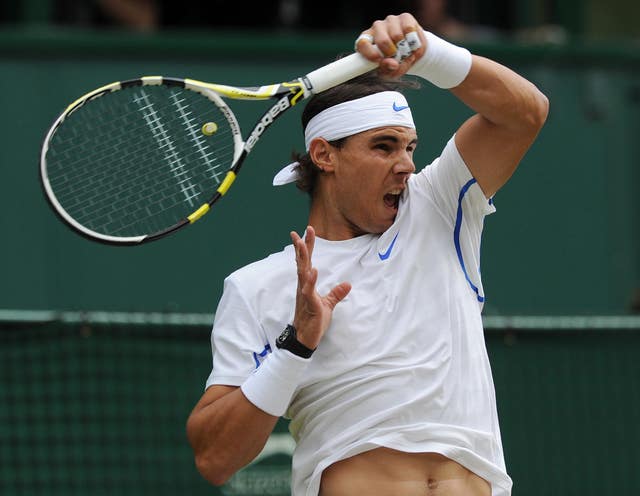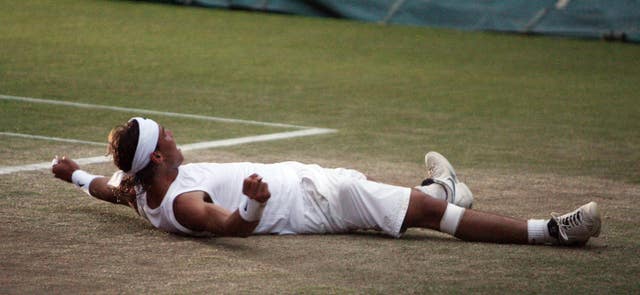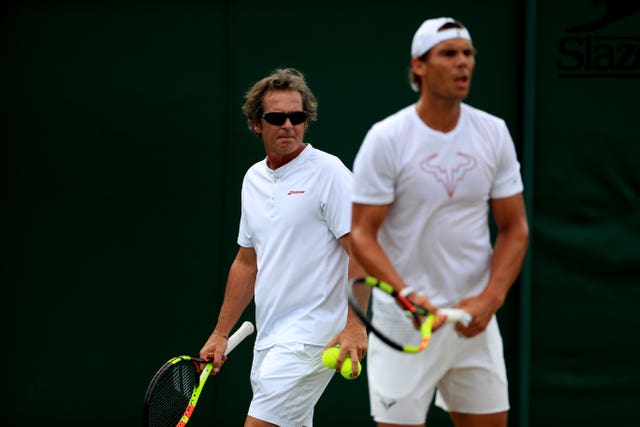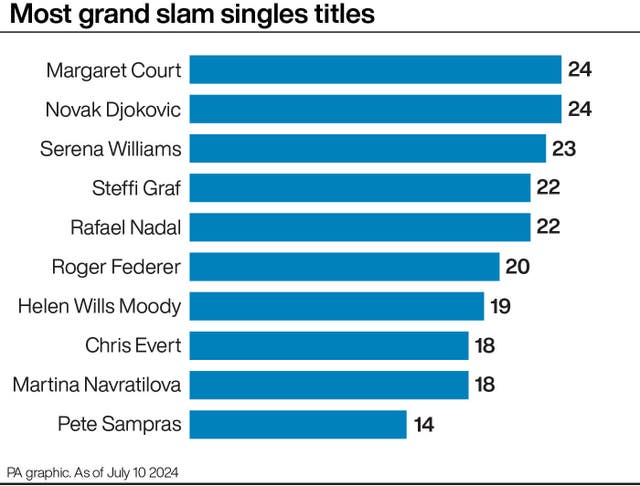
No matter how many times Rafael Nadal sent a full-power forehand flying down the line and into the corner, it always seemed that he achieved something impossible.
The left arm drew back, bicep rippling, before throwing the racket violently forward and up in a lasso motion around the head.
The opponent, who had previously felt in charge of the point, watched in staggered disbelief as the ball improbably flew past him and landed in the court.

The great Spaniard, who has hung up his racket at the age of 38, could hit his signature shot from seemingly any position, leaping across the court to unleash arguably the greatest weapon in tennis history.
While Novak Djokovic has surpassed Nadal in terms of numbers, the trophy room at the academy that bears his name is testament to his extraordinary career.
Pride of place, of course, are the 14 French Open trophies. So utterly dominant was Nadal at Roland Garros that it was easy to become a little blase about what is one of the most remarkable records in all of sport.
From winning his first title as a long-haired teenager in sleeveless top and knee-length shorts, Nadal lost just three matches across the next 17 years.

He quickly showed, though, that anyone putting him into a box marked ‘clay specialist’ was sorely mistaken.
Not since Bjorn Borg had a man won the French Open and Wimbledon back-to-back but, after successive final losses to Roger Federer at SW19, Nadal achieved the feat in 2008 in arguably the greatest match of them all.
The mental fortitude that the Spaniard showed in putting behind him losing a two-set lead and two match points to win 9-7 in the fifth set in the London gloaming encapsulated Nadal in all his greatness.
Has any athlete ever managed to live up to Rudyard Kipling’s words of meeting with triumph and disaster and treating those two imposters just the same, which are inscribed above the entrance to Centre Court, quite so well?
Rafael Nadal. 2008 final. Down the line forehand.
You know the rest 💥 #Wimbledon | @RafaelNadal pic.twitter.com/KdK9FwK3dg
— Wimbledon (@Wimbledon) May 18, 2023
Nadal never seemed to dwell on a winning point or a losing point, playing each ball on its merits and each match with the same ferocious intensity.
But Nadal the warrior was a construct, completely different to the rather nervous man who likes nothing better than spending quiet days with his family and friends back home in Manacor, Majorca.
His pre-match rituals, the neuroses evident in the way he arranged his water bottles and picked at his shorts and his face before each point, were a way to transform Nadal the person into Nadal the player.
It was no surprise he chose a sporting career given his background. His uncle, Miguel Angel, was a renowned footballer with Barcelona and Spain but it was another uncle, Toni, who was to shape his future.

Toni coached children at the local tennis club and at four years old Nadal joined his sessions. There was no favouritism. Quite the opposite. Nadal remembers Toni being harder on him than the other children, and the coach’s determination to build endurance in his young relative certainly paid dividends.
Discipline was a cornerstone of the Nadal family and the Spaniard famously never threw or broke a racket in anger during his career having had it drummed into him by Toni that he needed to value what he had.
The dynamic remained the same even when Nadal became the number one player in the world and was achieving feats never before seen.
A chat with Toni about Nadal’s latest record would always draw the same answer – ‘My nephew is not special. If he can do it, others can too’.

Modesty has always been one of Nadal’s hallmarks but even he at times seemed irked by this constant downplaying of his success.
Former world number one Carlos Moya – previously Majorca’s most famous tennis star – joined the team in 2016 and the following February Toni announced he would no longer coach his nephew and would instead concentrate on running Nadal’s academy in the family’s home town.
At the time it seemed Nadal’s best years were behind him. His ongoing battles with his own body had finally had an impact on his belief and he had not won a grand-slam title since the 2014 French Open.
But Moya proved the right man at the right time, encouraging Nadal to step into the court and trust himself as an offensive force, and helping him restore his confidence.

He went on to win eight more slam titles, reasserting his dominance at Roland Garros and winning two more US Open crowns to take his New York tally to four.
By winning the French Open in 2020, Nadal equalled his great rival Federer on 20 slam titles, before both were joined by Djokovic.
As Nadal began to struggle, not with his previously troublesome knees but with a chronic foot problem that he had been able to manage throughout his career, it seemed the end was nigh late in 2021.
He turned up at the Australian Open in January 2022 not knowing how he would hold up physically and went on to pull off his most remarkable triumph, lifting the trophy in Melbourne for the first time in 13 years.
King Rafa 👑 pic.twitter.com/QBrG7MdYsK
— Roland-Garros (@rolandgarros) October 10, 2024
Another French Open followed despite Nadal’s foot causing him so much pain he left Paris on crutches. He also won Wimbledon twice – he is one of only four men to win all the slam titles at least two times – as well as Olympic gold medals in singles and doubles and five Davis Cup triumphs with Spain.
That his career extended into his late 30s is one of Nadal’s most significant achievements given his numerous injuries and the strain put on his body by the gruelling nature of his game.
It could not go on for ever, of course, and there is no doubt Nadal’s retirement leaves a gaping hole both in the sport and in the lives of his millions of fans around the world.
For those players who no longer have to worry about his forehand, though, there may be a little sigh of relief.


Why are you making commenting on The National only available to subscribers?
We know there are thousands of National readers who want to debate, argue and go back and forth in the comments section of our stories. We’ve got the most informed readers in Scotland, asking each other the big questions about the future of our country.
Unfortunately, though, these important debates are being spoiled by a vocal minority of trolls who aren’t really interested in the issues, try to derail the conversations, register under fake names, and post vile abuse.
So that’s why we’ve decided to make the ability to comment only available to our paying subscribers. That way, all the trolls who post abuse on our website will have to pay if they want to join the debate – and risk a permanent ban from the account that they subscribe with.
The conversation will go back to what it should be about – people who care passionately about the issues, but disagree constructively on what we should do about them. Let’s get that debate started!
Callum Baird, Editor of The National
Comments: Our rules
We want our comments to be a lively and valuable part of our community - a place where readers can debate and engage with the most important local issues. The ability to comment on our stories is a privilege, not a right, however, and that privilege may be withdrawn if it is abused or misused.
Please report any comments that break our rules.
Read the rules here